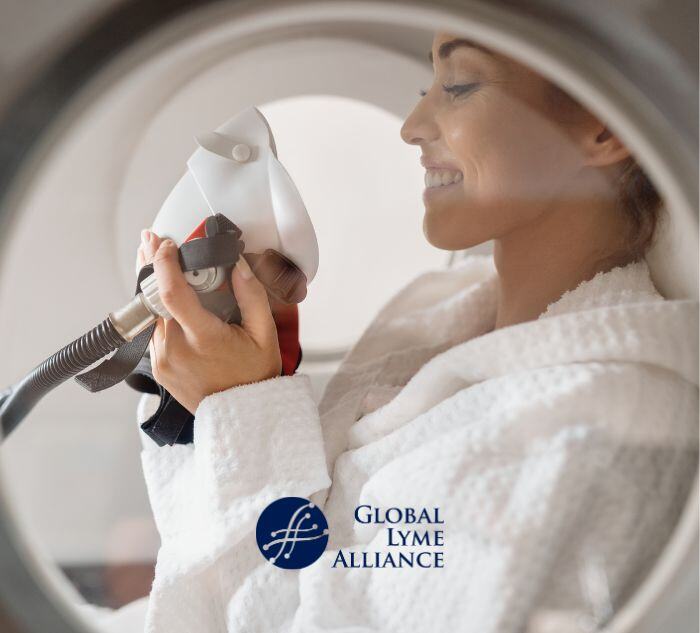
Learn about Hyperbaric Oxygen Therapy (HBOT) as a potential treatment for Lyme disease, from its effectiveness, risks, and current research findings.
Transmitted by the bite of a black-legged tick carrying Borrelia burgdorferi, Lyme disease is a bacterial infection that affects 476,000 people in the U.S. each year. Many more cases are unreported, and various strains of Lyme are a serious problem in countries around the world. In addition to Lyme disease, ticks can also transmit co-infections such as babesiosis and Powassan virus.
If Lyme disease is not complicated by co-infections and is diagnosed and treated early, it can often be cleared with a course of antibiotics. Still, 10-20% of patients go on to experience persistent symptoms. Others who are not diagnosed until Lyme has reached a later stage have more serious complications that can include neurological or cardiac symptoms or Lyme arthritis.
When antibiotics alone do not fully treat the symptoms of tick-borne disease, patients look to other therapies such as herbal medicine, SOT therapy, red light therapy, and adjunct therapies like integrative manual therapy and neurofeedback. One alternative therapy that some patients consider is hyperbaric oxygen therapy (HBOT). Let’s walk through what HBOT is, the current state of research on its use for Lyme disease, and its risks and benefits.
What is Hyperbaric Oxygen Therapy (HBOT)?
Hyperbaric oxygen therapy involves breathing pure oxygen in a chamber where the air pressure is two to three times higher than regular air pressure. These conditions allow the lungs to gather more oxygen than they could at normal air pressure and increases the amount of oxygen blood can carry. The extra oxygen helps promote healing by releasing growth factors and stem cells, and fighting infection. i
What is HBOT Used For?
HBOT is used for many different medical conditions. Scuba divers use it to treat decompression sickness. According to the Mayo Clinic, it’s also used for wounds that may not heal due to radiation injury or diabetes, bubbles of air in blood vessels, serious infections, severe anemia, brain abscess, burns, carbon monoxide poisoning, sudden deafness, gangrene, tissue death caused by skin or bone infection, and sudden painless vision loss.ii
What Does HBOT Involve?
HBOT can be done either in a single person or a multi-person chamber. Depending on the size of the chamber, you might sit or lie down. Oxygen will be delivered via a mask on your face or a light-weight clear hood placed over your head. During the session, you will feel temporary pressure in your ears, like what you might feel on an airplane or at a high elevation. The feeling can usually be relieved by swallowing or yawning.iii
HBOT sessions are about two hours, and multiple sessions are needed for HBOT to be effective.iv
What Are the Risks of HBOT?
HBOT is generally a safe procedure, but it does carry some risk. The Mayo Clinic notes that rare but possible side effects include middle ear injuries (including leaking fluid and eardrum rupture), temporary nearsightedness, lung collapse, seizures from too much oxygen, and low blood sugar in people with diabetes treated with insulin.v
HBOT and Lyme Disease
HBOT has not been FDA-approved to treat Lyme disease, but some doctors use it off-label for tick-borne illness. At this time, there is very limited evidence that HBOT improves chronic Lyme symptoms.
A case report from Taiwan describes a patient with chronic Lyme disease who experienced significant symptom relief – such as disappearance of joint pain, eye twitch, sleep disorder, numbness of extremities, and poor short term memory – after undergoing thirty 90 minute HBOT sessions. However, this report does not include long-term follow-up to see if his symptoms return.ii
In research, a single preliminary study in 2000 suggested that hyperbaric oxygen may inhibit the growth of Borrelia burgdoreri (the bacteria causing Lyme disease) in test tubes and mice. But additional research has not been conducted since then.iii
Patient-reported data about effectiveness and side effects of different alternative treatments for chronic Lyme symptoms have been gathered by LymeDisease.org. According to their 2019 MyLyme Data Chart Book, 347 patients tried HBOT and reported 22% effectiveness but also resulted in some moderate to severe side effects.iv
 Figure courtesy of lymedisease.org/mylymedata
Figure courtesy of lymedisease.org/mylymedataFurther research and clinical trials are needed to determine if HBOT truly helps chronic Lyme patients. If you are considering HBOT, talk to your Lyme Literate Medical Doctor (LLMD) to see if HBOT is appropriate for your particular case.
[1] https://www.mayoclinic.org/tests-procedures/hyperbaric-oxygen-therapy/about/pac-20394380
[2] https://hyperbaricoxygentherapy.com/conditions/investigational/lyme-disease
[3] https://www.nationalhyperbaric.com/hbot-treatments-and-conditions/lyme-disease
***
The above material is provided for information purposes only. The material (a) is not nor should be considered, or used as a substitute for, medical advice, diagnosis, or treatment, nor (b) does it necessarily represent endorsement by or an official position of Global Lyme Alliance, Inc. or any of its directors, officers, advisors or volunteers. Advice on the testing, treatment or care of an individual patient should be obtained through consultation with a physician who has examined that patient or is familiar with that patient’s medical history.

